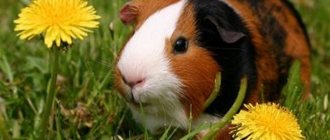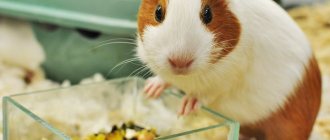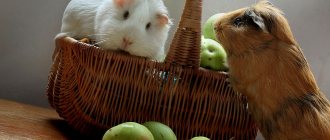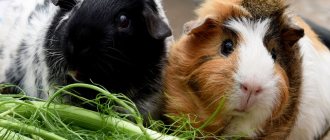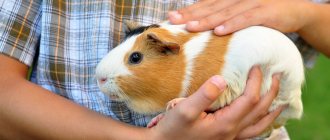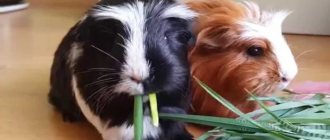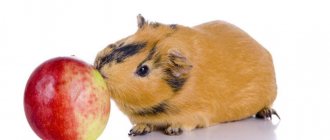- home
- Guinea pig
- Guinea pig nutrition
03/12/2019 Guinea pigs are adorable little animals with colorful spotted fur. These gentle rodents are staunch vegetarians. Before getting such an animal, it is worth asking what it eats and whether it is possible to give guinea pigs seeds and other similar products.
Can guinea pigs eat seeds?
Guinea pigs belong to the class of rodents. Despite their small size, they have very strong teeth that easily process solid food. A guinea pig's daily diet must certainly include fruits, vegetables, herbs, grains, berries, i.e. foods that contain vitamins and minerals and are so necessary for the animal. Before feeding guinea pigs, vegetables and fruits should be washed under running water and divided into small portions (80-120 g per day).
In special pet stores you can buy ready-made mixtures for feeding rodents. Some foods contain unshelled sunflower seeds. Many owners are afraid to introduce seeds into their animal’s diet and deliberately remove them. But this should not be done, unless, of course, the animal has an individual intolerance to this product.
- Firstly, the seeds contain fatty acids and are a valuable nutritious food.
- Secondly, seeds contain calcium, sodium, phosphorus, proteins and vitamins.
- Thirdly, all rodents love seeds, especially in the initial (milk) stage of ripening.
Seeds are given to guinea pigs only in raw form. But it should be borne in mind that the seeds are rich in fat, and this is harmful to the liver. The daily intake of seeds is 15% of the total grain mixture. Before giving seeds to an animal, they must be shelled.
The most interesting news:
Can rabbits be given rice?
The health of rabbits largely depends on its nutrition, so if the owner wants it…
Article on the topic: Is it possible to give guinea pigs cherries?
Is it possible to give rabbits compound feed?
A balanced and nutritious diet is the key to good rabbit health. The animal’s diet must include...
Is it possible to give rye to rabbits?
Rye is one of the unique types of grain that has exceptional benefits for humans. Especially…
Rules for feeding vegetables
Basic rules for feeding vegetables to guinea pigs:
- Only fresh products are allowed for consumption. If the pet doesn't finish eating, the leftovers are thrown away.
- Vegetables, especially root vegetables, are thoroughly washed. There should be no dirt left on the peel.
- Lettuce and cabbage should be washed and dried before eating.
- The most useful vegetables are those collected from your own garden.
If you follow simple rules, your guinea pig will be in good health and in a good mood.
Menu for guinea pig
What can you feed guinea pigs? What foods should you avoid? Should I give them nutritional supplements? In this article you will find answers to the most popular questions about healthy eating for your pets.
To keep your pig healthy and vigorous, the following ingredients must be constantly available in its access area:
- Water
- Hay
- Dry food - granules (not as important as hay and water).
We also highly recommend feeding your pig the following foods and nutrients:
- Vegetables (daily)
- Fruit (from time to time)
- Vitamin C (if the pig does not get enough from vegetables and fruits).
IMPORTANT: Guinea pigs have sensitive stomachs.
New foods should be introduced gradually into the animal’s diet. Start with a small piece, and if your pig likes the food, gradually increase the portion. Water
It is necessary that there is always clean and fresh water at room temperature in the pig's cage. Do not use distilled water (it lacks important minerals). Also, do not use water rich in minerals (especially calcium). It is not recommended to give animals untreated tap water (due to chlorine). It is best to use plain bottled water or fresh water from sources. Pour water into a special nipple drinker - the water does not spill from it, and the pig can drink whenever he wants. Clean the nipple regularly.
Hay
Guinea pigs are herbivores. It is recommended to feed your pig an unlimited amount of grass hay for three reasons:
- Pig teeth grow throughout their lives. They need to constantly grind hay to keep their teeth from growing too much.
- Grass hay is good for the gastrointestinal tract.
- You can't get fat from it. At the same time, hay is a source of protein.
Article on the topic: Can guinea pigs eat apricots, peaches and nectarines?
Remember - when you buy hay, it should smell good and be greenish in color. Be careful not to buy straw instead of hay (straw is brown, much tougher and contains virtually no nutrients).
IMPORTANT: dry food cannot replace hay. Its absence in the pig's diet leads to abnormal tooth growth and stomach problems.
Dry food for guinea pigs
It is not as necessary as hay, but is still important because... contains essential nutrients. Give your pigs ¼ - 1/8 cup of dry food without added dyes. It can be placed in a small but heavy (so that the animal does not turn it over) ceramic bowl. It is recommended to purchase dry food with added vitamin C. The food should be stored in a dry, dark and cool place. When purchasing, always pay attention to the expiration date of the food. Do not give pigs food for other small animals, because... their composition varies. Dull gray granules are preferable as they do not contain chemical dyes.
Vegetables
- Feed your guinea pig mostly green leafy vegetables.
- Some vegetables can be given daily, others only a few times a week.
- It is necessary to remove half-eaten vegetables to prevent them from rotting.
- Do not give your animal wilted or spoiled vegetables.
- Don't feed your pig the same vegetables every day. The key to her health is variety.
- Be careful with food from the refrigerator: very cold food can cause diarrhea in your pig.
- NOT recommended: iceberg lettuce and cabbage vegetables.
Vegetables your guinea pig can eat daily:
Cucumbers, green bell peppers (seeds must be removed), carrots, lettuce, zucchini, artichokes, radishes, dill, cilantro, sweet potato leaves, arugula, chicory, chard.
Article on the topic: List of vegetables and fruits that can be given to guinea pigs
Vegetables that your pig can eat 2-3 times a week:
Red and orange bell peppers (seeds removed), asparagus, basil, leeks, thyme, pumpkin (without seeds), spinach, turnips, broccoli, cauliflower, bok choy, parsley, celery, beets, tomatoes.
Fruits
IMPORTANT: Many fruits contain large amounts of sugar and fruit acid, which can lead to gall bladder problems. Therefore, they should be given to guinea pigs occasionally, as a treat and in very small quantities (1/8 of an apple or orange, for example) 1-2 times a week. Fruits must be finely chopped.
Guinea pigs can eat the following fruits:
- apple, pear: you must first peel and remove the seeds
- dried apricots, banana, blueberries, orange, strawberries, melon, grapefruit, kiwi, mango, raspberries, peach, plum, figs.
IMPORTANT: Grapes can cause kidney disease, so do not feed them to your pigs.
Vitamin C
Guinea pigs are one of the very few mammals that do not produce vitamin C themselves, so they need to get it through food and supplements. If pigs don't get enough vitamin C, their immunity weakens and they may even get scurvy. A healthy adult pig should receive 10 to 30 mg of vitamin C per kg of body weight daily. Sick and pregnant pigs need at least 30 mg per 1 kg daily.
ATTENTION! Under no circumstances should you give guinea pigs foods from the following list: canned food, pickles, pickled vegetables and fruits, potatoes, nuts, beans, gooseberries, mushrooms, chili peppers, dairy products, meat, fish, eggs, bread, chocolate, sweets, corn, avocado, coconuts, garlic, and a herb you don't know the name of.
Can pumpkin be harmful?
Contains a large amount of fiber. It is not recommended for daily use by hamsters.
If you feed your hamster pumpkin more and more frequently, changes in the color of the rodent's coat may occur. So, for example, the fur of a white hamster will turn yellow, a cream hamster will turn orange, and a black hamster will turn brown.
What do you feed guinea pigs?
The animal needs about 100 grams of varied and healthy food per day. The approximate ratio of all types of products looks like this:
- up to 10% is dry food,
- 30% - succulent feed,
- the remaining 60% is hay.
The main share of succulent food comes from vegetables: beets with tops, carrots, zucchini, white and cauliflower cabbage (in small quantities), pumpkin, bell peppers, turnips, green pea pods, rutabaga, occasionally tomatoes and cucumbers.
These animals benefit from fruits, berries and greens (nettle, clover, green onions, spinach, salads). Before feeding pigs, food must be thoroughly washed.
Pigs are herbivorous rodents, so granules and grain mixtures should not form the basis of their diet. However, many feed manufacturers add sunflower seeds to their products. Thus, in one form or another they are present in the diet.
Benefits of pumpkin for rodents
In their natural habitat, hamsters love to eat not only grains, seeds and nuts. They enjoy searching for new food and nibbling on fresh plants, as well as fruits and vegetables. Among the latter is a rich list of fruits that can be fed to hamsters as their main food.
In the summer, seasonal vegetables appear in the diet of small pets. They contain important and necessary minerals, vitamins, and plant sugars.
These vegetables include raw pumpkin. Its juicy pulp copes well with thirst and is well suited as a treat for hamsters. It contains a complex of vitamins: B, C, E, PP. Rich in phosphorus, iron, potassium and protein.
Fruits and berries
Bananas
Can guinea pigs have bananas? A banana rich in potassium will benefit your guinea pig, but you should not give more than 1 piece per day.
The peel of the vegetable must be removed, as it is treated with substances hazardous to health (wax, chemicals, ethylene and pesticides). For safety, it is better to remove soft fibers from the fruit.
Can guinea pigs eat a pear?
Pears can be given with the peel, but without the seeds. The fruit is washed well and cut into pieces; the pig should be offered water along with it. Excessive consumption of pears due to their high sugar content can cause diarrhea.
Can guinea pigs eat kiwi?
Kiwi is a very healthy fruit for animals. It contains a large amount of ascorbic and folic acids. It is also rich in vitamins E, iron, calcium, magnesium and phosphorus.
Kiwi is given without skin in the form of small pieces. For your pet, you need to choose harder fruits. It is better to control the amount you eat. An increase in the dose of kiwi is permissible in autumn and winter, as well as when feeding females during pregnancy and lactation.
Can guinea pigs have oranges and other citrus fruits?
Can be used occasionally. But it is better for guinea pigs to get vitamin C from other foods, avoiding citrus fruits. Possible complications:
- oversaturation with vitamins;
- skin irritation;
- oxidation of urine.
Can guinea pigs eat apples?
Apples can be raw or dried. They have a balanced ratio of sugar and fructose (18:80%). It allows the pig to be active.
The fruit must be peeled and cut into slices. It is better not to give more than 3 pieces at a time.
Can guinea pigs eat strawberries, grapes and other berries?
Strawberries contain a sufficient amount of vitamin C to pay attention to the berry when choosing a treat for a rodent. You can also give strawberry leaves to animals.
- The pig might like grapes. You can offer the animal seedless grapes.
- Eating currants once a week will also not harm your pet.
- If you do not abuse it, you can offer the pig berries and raspberry leaves, berries, leaves and branches of blueberries, blackberries and sea buckthorn, and rose hips without seeds.
- Cranberries are given for medicinal purposes. It has an anti-inflammatory effect on the mucous membranes of the mouth, stomach, and bladder.
Other products
Can guinea pigs eat bread? It's better not to give.
- Fresh yeast bread takes a long time to digest and causes fermentation in the animal’s stomach.
- White bread causes bloating.
- Your pet can eat stale bread, but not often.
- Dried bread with seeds, sesame seeds and raisins can sometimes be offered to your pet as a treat.
Can guinea pigs eat nuts and seeds?
Nuts and seeds are among the allowed foods, but can cause obesity if their consumption is not limited. It is better to offer your pet almonds, walnuts or hazelnuts.
The seeds contain many components useful for the animal: fatty acids, calcium, sodium, phosphorus, proteins and vitamins. It is better to give peeled seeds and make sure that they are no more than 15% of the total feed.
Effect on the body
When introduced moderately and periodically into the diet, nuts have a positive effect on the body of domestic rodents. They make it possible to saturate the body with the necessary energy and protect the animal from exhaustion, and this property is especially important for the young and most active animals. In addition, the product provides the body with all kinds of microelements and vitamins that are important for maintaining optimal tone and immunity, as well as the healthy functioning of the cardiovascular system.
In addition, any type of nut contains antioxidants . These compounds are especially important for the body of pets, as they help reduce the impact of free radicals and other harmful compounds on organs and tissues. And this allows you to reduce the risk of developing disorders of both individual organs and various systems.
You should definitely remember that nuts are important for rodents and as a source of external beauty. They are rich in vitamin E, which is considered the best way to protect fur from fragility, loss and other cosmetic problems. At the same time, the vitamin makes it possible to make the coat soft and give it a healthy shine.
Are apples acceptable in the diet?
For these animals, apples are a delicacy along with pears and cucumbers. The type of apples doesn't really matter. But you should try to take into account at least the amount of sugars contained in the fruit. A lot of sweets in the diet is harmful for both people and guinea pigs. Apples are best given to your pig in the evening along with other types of food. This method contributes to the better appearance of the animal.
If we talk about the preferences of guinea pigs, then the animals themselves prefer sweet varieties of apples. If the apples are dried, then before serving it is recommended to soak them in water for 3 hours before treating your pet. Spoiled and rotten fruits should not be given to the pig. In addition to the fruits of the apple tree, as well as the branches, they are suitable for food consumption. The fruits can be fed both dry and raw.
The fruits contain useful substances such as:
- fiber with fructose;
- pectin;
- vitamins of group B and other important structures;
- a number of useful minerals.
Many owners cut apples before serving, but the best way to serve them is to serve them whole.
If the owner decides to cut the apples, it is important to remove all the seeds. They contain acid, which, when dissolved in the stomach, can become dangerous for a pet.
According to recent studies, the poison of even one berry is enough to kill a pet.
The available dietary fiber helps in overall cleansing of the body. Despite the fact that apples should be included in the regular diet, if you take into account the answers from experienced breeders, the benefits of fruits can be increased significantly:
- The apple fruit must be washed thoroughly and cut into small pieces;
- make sure there is no mold on the fruit;
- leave the seeds;
- the fruit should be moderately ripe, but not too juicy. Fibers that are too soft do not have the best effect on the condition of the animal’s incisors and muzzle. If the muzzle is very dirty, such an environment can become ideal for the growth of bacteria;
- It is not recommended to give sour fruits. The acids contained in the fruit can negatively affect the functioning of the gastrointestinal tract.
It is forbidden to give pieces of compote. The mass will turn sour in the stomach, it will not be digested, resulting in poisoning. Experienced breeders advise giving apples to your pet in the first half of the day. Unlike hamsters, animals eat less often at night and fiber may be less absorbed.
One serving should contain no more than 3 apple slices; it is advisable to treat your pig with a treat no more than 2 times a week. Due to the large amount of sugars, apples can cause obesity in large quantities.
Treatment of cystitis
To prevent the guinea pig from experiencing additional stress in an unusual environment and from freezing outside, a veterinarian is invited to the house. The patient is placed in a warm place, the groin area is insulated, fed with cereals, roots, fruits and given water. Treatment methods are selected taking into account the severity of cystitis and the presence of concomitant pathologies.
If pus forms in the bladder, a catheter is inserted and the cavity is washed. After determining the sensitivity of the pathogen to the active components of the drugs, the veterinarian selects an antibiotic and a drug from the sulfonamide group. Chloramphenicol is often administered subcutaneously, the manipulation is carried out twice a day, using 5 g of antibacterial agent per 100 g of animal weight.
For oral administration, a nitroxoline tablet is dissolved in 100 milligrams of hot or boiled water. The prepared product is given to the pig three times a day at the rate of 0.6 ml per 100 g of body weight. Pain during urination is relieved with belladonna suppositories.
To prevent serious consequences, even when the animal becomes active again, it appears healthy, the course is not interrupted until the end. If there is no improvement, the mumps is brought to the clinic, an x-ray is taken to rule out or confirm the localization of stones in the bladder, which are removed surgically.
The question “what to feed a guinea pig” depends on its life. In less than a day, the hungry animal's intestines stop and it dies. If you refuse food, there are two options - force feeding or euthanasia. Contents of the article: General feeding rules How many times a day to feed What to feed a guinea pig What not to feed guinea pigs Video about diet
Is it possible to give nuts?
As a rule, all kinds of guinea pigs are herbivores. That is why the basis of their diet should be juicy and dry herbs, as well as fruits and berries. It is recommended to feed rodents with cereal grains and various peeled seeds. It is believed that nuts are unnecessary for guinea pigs, since in the wild they eat them quite rarely.
However, this product is still approved for feeding rodents. It has a beneficial effect on the health of individual organs and systems of the body. In addition, nuts are extremely important for the young and most active pigs: they are one of the best sources of energy.
How to give pumpkin correctly
The food we feed our favorite animals directly affects their well-being and appearance. Most often, when the owner wants to pamper his pet and treat him to “something tasty,” such delicacies are strictly contraindicated for hamsters.
It is allowed to carefully give your pet a taste of this or that vegetable in small portions and observe the reaction. However, hamsters are quite capable of digesting the pulp of fresh pumpkin.
For variety, furry rodents can periodically include raw or processed pumpkin in their diet. One option is to give hamsters stewed, steamed or boiled pumpkin.
The first step is to wash the product well. Then serve it like this or heat treat it. When you bring a purchased pumpkin from the store, you should definitely wash it well, and it is best to remove the peel in a very thick layer.
It is necessary to cut the peeled flesh into small pieces to make it easier and more convenient for the hamster to eat them. Also, it is important to promptly remove uneaten leftovers from the cage, otherwise they will begin to rot, and the animals should eat only fresh food.
Canned vegetables are never suitable for feeding your furry friend!
The best quality vegetable is always the one that was grown in its own garden, without treatment with pesticides.
Read also
Light mode
Light regime Light has a positive effect on the productivity of birds, the growth and development of young animals. Streams of light enter the retina and, in the form of nerve impulses, have a stimulating effect on physiological processes in the body. This contributes
Feeding regimen and diet
Diet and Diet The animal's diet must be strictly observed. Small puppies need to be fed 6 times a day until they reach 2 months of age; 2-4 month old animals - 4 times; Puppies 4-6 months old - 3 times; from 8 months - 2 times
Light mode
Lighting conditions Sunlight plays a minor role in the development of hamsters. It has been scientifically proven that light from incandescent and gas lamps completely replaces natural sunlight, with the exception of the effect of ultraviolet radiation
Feeding mode
Diet The correct diet consists of observing the frequency and quantity of feedings, observing the rules for the dog’s food consumption, its age, health status and energy expenditure. The animal’s work must be strictly observed
Feed preparation, feeding regimen and rules
Cooking, diet and rules. Particular care should be taken when preparing dog food for both hygienic and medical reasons. The fact is that products lose a significant part of their beneficial substances during heat treatment,
Light mode
Lighting Conditions Sunlight plays a minor role in the development of guinea pigs. It has been scientifically proven that light from incandescent and gas lamps completely replaces natural sunlight, with the exception of ultraviolet exposure
Feeding regimen and hygiene
Diet and hygiene Guinea pigs must be fed strictly at certain times 2-3 times a day (pregnant females should be fed 3-4 times a day), giving them food at regular intervals. Evening feeding should be complete and constitute 40% of the daily diet.
PUPPY MODE
PUPPY REGIME From day one, Ike was put on a strict diet. They fed him six times a day. If he didn't finish something, the bowl was immediately removed. One day he refused to eat, hoping that later he could return to the bowl and finish the rest. But no
Feeding regimen and diet
Diet and Diet It is necessary to strictly follow the animal's diet: feed small puppies up to 2 months of age 6 times a day; 2-4 month old animals - 4 times; Puppies 4-6 months old - 3 times; from 8 months - 2 times
Feed preparation, feeding regimen and rules
Cooking, diet and rules. Particular care should be taken when preparing dog food for both hygienic and medical reasons. The fact is that during heat treatment, products lose a significant part of their beneficial substances.
Light mode
Light Regime Sunlight plays a vital role in the development of rats. Affects growth, physiological development, reproduction process, vitality, activity of animals. Science has established that light from incandescent lamps and gas lamps, with the exception of
Temperature
Temperature regime In winter, the temperature in the dovecote should be no lower than 5-7 ° C, and in summer no higher than 20 ° C. Pigeons come from southern subtropical countries, so the optimal temperature for keeping them is within 20 °; pigeons do not tolerate heat well, harsh
Hygiene
Hygiene Combing and cutting the griffin's coat requires constant care. It is recommended to clean it regularly with a brush specifically designed for this purpose. It is better not to use a regular comb, as its hard and sharp teeth can seriously injure the delicate
Feeding mode
Feeding regimen Chickens of meat breeds are fed 3-5 times a day. In autumn and winter - at 8, 12 and 18 (further meals are possible at 16:00), and in spring and summer - at 6, 8, 12 and 18 (further meals are possible at 20:00). With cellular content
Curious and witty guinea pigs quickly begin to recognize their owner, do not like loneliness, and enjoy communicating with family members

